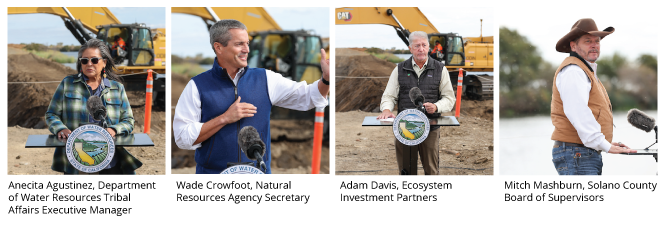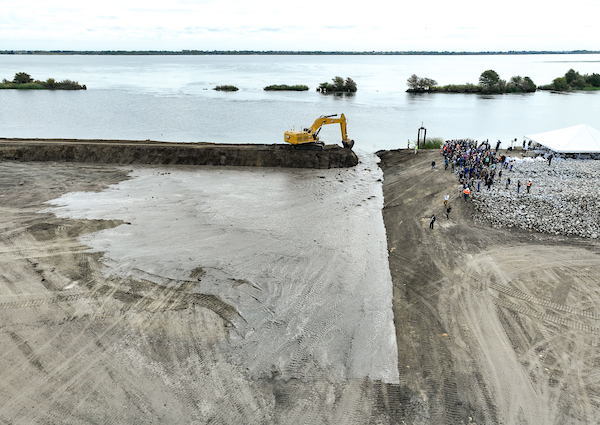Guest Author: Adam Davis, Ecosystem Investment Partners (EIP)
September 18, 2024, marks a significant milestone for the Sacramento-San Joaquin Delta as the Lookout Slough Tidal Habitat Restoration and Flood Improvement Project reached a pivotal moment with the levee breaching ceremony. This event is not just a testament to the project’s progress but also a symbol of the ongoing efforts to restore one of California’s most vital and fragile ecosystems.
 Speakers at today’s levee breaching ceremony | Photos provided by California Department of Water Resources
Speakers at today’s levee breaching ceremony | Photos provided by California Department of Water Resources
Delta’s Largest Tidal Restoration Project
The Lookout Slough project is the largest single tidal habitat restoration effort in the Delta to date, restoring approximately 3,400 acres of former farmland, ranchland, and duck-hunting grounds in the Cache Slough region. Spearheaded by the California Department of Water Resources (DWR) in partnership with Ecosystem Investment Partners (EIP), this project forms part of a broader initiative to create 16,000 acres of contiguous tidal wetland restoration in the area. The project’s size and scope make it an essential piece of DWR’s commitment to fulfilling the 2008 Delta Smelt Biological Opinion (BiOp) and aligns with the objectives of the 2009 National Marine Fisheries Service (NMFS) Salmonid BiOp.
The restoration aims to support native species, including the endangered Delta smelt, while simultaneously providing much-needed flood risk reduction for the surrounding communities. By integrating flood control and habitat restoration, Lookout Slough embodies the multi-benefit approach crucial to sustaining California’s natural systems in the face of drought, climate change, and evolving ecological challenges.
One of the key features of the Lookout Slough project is the creation of diverse intertidal and subtidal habitats designed to support a variety of native species. More than 75% of the restored area will become intertidal habitat, providing crucial food sources and breeding grounds for Delta smelt, longfin smelt, Chinook salmon, green sturgeon, and many bird species.
The restoration includes constructing a network of over 26 miles of new tidal channels and strategically planting riparian vegetation to foster a robust aquatic food web. The project team even discovered and relocated several threatened giant garter snakes from the construction areas and over 30 state listed Swainson’s hawks successfully fledged on the property during construction, preserving the site’s rich biodiversity. Additionally, the site’s design accommodates the impact of sea level rise and future climate change, ensuring that the tidal habitats can adapt and thrive over time.

Enhanced Flood Protection for the Delta
Lookout Slough is not only about habitat restoration; it is also about safeguarding the Delta communities from flooding. The project includes constructing a new 25-foot-tall setback levee along the site’s northern edge that allowed for breaching of the existing Yolo Bypass West Levee. This new levee provides 100-year flood protection and resilience against future climate change scenarios. Upon completion, the project will add 40,000 acre-feet of floodplain storage, diverting floodwaters away from nearby towns and infrastructure, thus reducing the risk of catastrophic flooding in the Central Valley.
While Lookout Slough’s primary purpose is ecological restoration and flood risk reduction, it will also provide recreational opportunities that enhance the area’s natural beauty and support wildlife observation. Although there will be no formal trails or land-based public access to protect sensitive habitats, the public will be able to access the new tidal channels for wildlife viewing, fishing, and hunting via a created non-motorized boat ramp at the northernmost breach.
A Model Public-Private Partnership
The success of Lookout Slough is largely due to the innovative public-private partnership between DWR and EIP. EIP utilized its Pay for Performance model to efficiently navigate the complexities of land identification, acquisition, permitting, and construction, while DWR provided oversight and long-term planning support. This collaboration propelled the project from planning to execution within six years—a remarkable achievement for large-scale restoration efforts of this magnitude. In addition to EIP, partners such as WRA Inc. and Environmental Science Associates (ESA) have provided critical expertise in environmental consulting, design, and permitting processes.
The Broad and Unified Vision for the Delta
Lookout Slough is part of a larger vision to restore up to 80,000 acres of habitat in the Sacramento-San Joaquin Delta. Its strategic location adjacent to other restored areas, including Yolo Flyway Farms, Lower Yolo Ranch, and Liberty Island, forms a contiguous tidal wetland restoration complex that spans 16,000 acres. This expansive restoration will create a more connected and resilient ecosystem, benefiting not only the Delta smelt but also the entire food web that relies on these habitats.
In the Sacramento Valley, NCWA and partners are advancing similar efforts to reactivate historic floodplains. Through initiatives like the Floodplain Forward Coalition, they are working to mimic natural processes to enhance habitats for fish, birds, and other wildlife, while also improving flood protection and groundwater recharge. These nature-based solutions are critical for creating vibrant landscapes and healthy river systems and communities. To learn more about these efforts, visit their blog Investing in Multiple Benefits through Floodplain Reactivation.
While the Delta smelt’s fate remains uncertain, the project is designed to support various species and provide widespread ecological benefits. By restoring natural tidal processes, Lookout Slough will enhance the Delta’s overall health, potentially improving conditions for migrating salmon and other native fish species.

As the tide flows back onto the land, Lookout Slough stands as a testament to what is possible when collaborative, multi-benefit projects are implemented. From increasing flood resilience to providing vital habitat for endangered species, this project exemplifies the type of forward-thinking projects needed to secure a sustainable future for California’s most precious resource.
Learn more about the project:
- Video highlights from Lookout Slough’s Groundbreaking in 2022
- Time lapse footage of levee breach at Vogal Island (part of Lookout Slough) in 2022





Hi, I went out the other day to see our county’s new slough project. The irony is that it’s called “Lookout slough” and yet the entire project is completely closed off with “ no trespassing “ signs and barricades.
One cannot look out at Lookout slough.
Will this project ever be available for our residence to see?
Dan